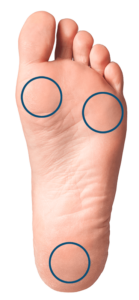Not too long ago we discussed the importance of sitting posture and how to achieve it. Now, we talk with Paul Ramos (aka “Sarge”), PTA, FAFS about achieving proper posture while you are standing and walking. Posture and walking mechanics play a huge role when it comes to improving stamina and gait, and is an often-overlooked aspect of our health and well-being. We have a lot to get through, so let’s jump in.
Learn about “Achieving Proper Sitting Posture” on the Spooner Blog.
Standing Posture
We’ll start with standing posture as it sets the framework for walking. Before we jump into the do’s and don’ts, there are a couple concepts we should cover first: body symmetry and pelvic attitude.

Symmetry relates to the way we distribute weight along the hips, knees, and feet.
The feet are our foundation and can be viewed as a tripod, with weight spread across the 1st metatarsal, 5th metatarsal, and calcaneus – or in layman’s terms, the balls of your feet below your big toe and pinky toe and the heel.
When weight is not evenly distributed along this tripod, we create a tilt that our ankles, knees, hips, and spine need to compensate for. This can lead to pain being broadcasted to other areas of the body which can result in a wasted effort to relieve pain since the root of the problem may not be being addressed. A physical therapist can review how your body moves to map out how pain is traveling through the body and pinpoint its origin.
Symmetry in the knees and hips is often thrown off when we shift our weight while standing. If you stand for a long period of time, you’ll find yourself unloading weight off one leg when it starts fatiguing. The longer you stand, the more you’ll find yourself switching back and forth. It’s natural to give your legs a rest when they need it, but it’s important to remember to return to an even weight distribution after giving your legs a little shake out. The uneven weight can cause one side to dip, forcing your spine to compensate in order to keep your head and upper body level.
Pelvic attitude describes how we position our pelvis while we stand. Our pelvis is the cradle for our spine, and when our pelvis is in a neutral position, we allow our spine to rest in its natural state. The pelvis can be pitched forward, backward, and side to side. When the pelvis is pitched forward, it is often the result of the heel not having a firm foundation to rest on. The weight in your body is likely biased towards the balls of your feet. On the flip side, a pelvis that is pitched backwards is likely the result of putting too much weight on the heels. This position will cause your back to slouch. In each case, the nerves in the spine become pinched leading to pain and sometimes more serious conditions.
While standing you’re going to want to do the following:
- Keep even pressure through your feet (remember the tripod)
- Gently keep your shoulders back but don’t force them back
- Keep your head upright and in-line with your shoulders
- Keep your core engaged
- Keep your knees slightly bent
- Keep your feet shoulder-width apart
Walking Posture
We like to think of walking as a very controlled falling, so posture is going to influence how you ‘fall’ and how you land. The stride we take when we walk should be comfortable and almost unnoticeable. We aren’t trying to push ourselves forward with long strides, but rather catch ourselves as we allow gravity and our natural momentum to carry us forward. By letting gravity do some of the work for us, our bodies get to conserve a little more energy. In addition, our feet should be landing heel-to-toe to cushion the impact of our weight landing as we walk. By taking shorter strides and letting our feet land heel-to-toe, we are minimizing the risk of overuse injuries, excessive joint impact and muscle strain, and fatiguing.
Something else to keep in mind is the natural rotation of our bodies as we walk. Our bodies are crisscrossed with muscles and tendons that help us maintain our balance and momentum while walking. When we walk, we are repeatedly setting up and releasing these muscles and tendons like they’re rubber bands. In a normal walk cycle, our hips and shoulders rotate, but they rotate opposite to each other. This means when your right leg is taking a step your left arm is swinging forward. This is a result of that crisscrossing and helps us wind up for the next step. When we take the next step, our muscles are released propelling the body forward.
The most important thing to remember about walking is that we are not trying to be forceful. By following these rules, you will see improvements in your walking posture:
- Keep your head up and looking forward
- Allow your torso to twist and engage your core
- Allow your arms to swing – this is a natural product of the torso twisting
- Avoid slouching
- Gently keep your shoulders down and back – forcing your shoulders back prevents them from rotating properly
- Allow your arms to swing – this is a natural product of the torso twisting
- Keep your stride short
- Roll your feet naturally heel-to-toe
Are you experiencing pain while you’re standing or walking? Want to make sure your posture is in the right place? Spooner Physical Therapy’s team of movement specialists are here to help!
Learn more about Spine Rehabilitation at Spooner Physical Therapy. Ready to schedule an appointment? Schedule an appointment or complimentary movement screen with a Spooner physical therapist at one of our locations throughout the valley.

